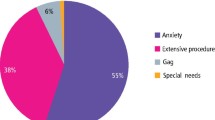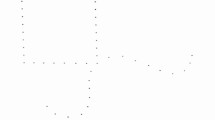Key Points
-
Discusses the use of the IOSN for general dental practitioners regarding the appropriate referral criteria to specialist services for patients with dental anxiety.
-
Provides a method by which dentists can reliably assess and tailor the sedation modality for patients with dental anxiety.
-
Shows the importance of assessing patient dental anxiety and treatment complexity in the decision making process.
Abstract
Aim To conduct an exploratory investigation of public dental service (PDS) practitioners' planned sedation modality using a structural equation modelling approach, in order to identify the explanatory value of using the Index of Sedation Need (IOSN), or its component parts, to predict sedation modality in patients referred with dental anxiety.
Methods A convenience sample of patients referred to the PDS for dental anxiety management was invited to take part. The IOSN was completed for each patient (patient dental anxiety, medical and behavioural indicators and dental treatment complexity) as well as the American Society of Anesthesiologists Physical Status Classification System and the Case Mix Tool. The practitioners completed details of their planned sedation modality and identified normative dental treatment need. The data were entered onto an SPSS v21 database and subjected to frequency distributions, t-tests, correlation analysis and exploratory partial structural equation modelling (SEM).
Results Ninety-five percent of patients were ranked as MDAS 3 or 4, indicating high dental anxiety; 69% had a medical condition, which might impact on dental treatment and 82% had a dental treatment need, which was classified as intermediate/complex according to the IOSN. Eighty-eight percent of the patients in accordance with the IOSN required sedation: 62% of patients were assessed as requiring intravenous sedation. The IOSN discriminated between patients who were assessed as requiring more complex sedation modalities and had a greater normative treatment need. The SEM showed that the patient dental anxiety (P <0.02) and dental treatment complexity (P <0.02) predicted planned sedation modality. Functional morbidity was less strong, as a predictor, and was significant at the ten percent level.
Conclusions The IOSN is a useful and valid assessment of sedation need and predicted sedation modality for patients referred with high dental anxiety states and secondly, that component parts of the IOSN add explanatory value in practitioners' choice of planned sedation modality.
Similar content being viewed by others
Log in or create a free account to read this content
Gain free access to this article, as well as selected content from this journal and more on nature.com
or
References
The Dental Faculties of the Royal Colleagues of Surgeons and the Royal College of Anaesthetists. Standards for conscious sedation in the provision of dental care. report of the intercollegiate advisory committee for sedation in dentistry, 2015. Available online at http://www.rcseng.ac.uk/fds/publications-clinical-guidelines/docs/standards-for-conscious-sedation-in-the-provision-of-dental-care-2015 (accessed November 2015).
Coulthard P. The indicator of sedation need (IOSN). SAAD Digest 2012; 28: 8–12.
Coulthard P, Bridgman C M, Gough L, Longman L, Pretty I A, Jenner T . Estimating the need for dental sedation. 1. The indicator of sedation need (IOSN) - a novel assessment tool. Br Dent J 2011; 211: E10.
Pretty I A, Goodwin M, Coulthard P et al. Estimating the need for dental sedation. 2. Using IOSN as a health needs assessment tool. Br Dent J 2011; 211: E11.
Goodwin M, Pretty I A . Estimating the need for dental sedation. 3. Analysis of factors contributing to non-attendance for dental treatment in the general population, across 12 English primary care trusts. Br Dent J 2011; 211: 599–603.
Goodwin M, Coulthard P, Pretty I A, Bridgman C, Gough L, Sharif M O . Estimating the need for dental sedation. 4. Using IOSN as a referral tool. Br Dent J 2012; 212: E9.
Liu T, Pretty I A, Goodwin M . Estimating the need for dental sedation: evaluating the threshold of the IOSN tool in an adult population. Br Dent J 2013; 214: E22.
American Society of Anesthesiologists. ASA physical status classification system. Available online at https://www.asahq.org/resources/clinical-information/asa-physical-status-classification-system (accessed November 2015).
Bateman P, Arnold C, Brown R et al. BDA special care case mix model. Brit Dent J. 2010; 208: 291–296.
Duane B G, Humphris G M, Richards D, O'Keefe E J, Gordon K, Freeman R . Weighing up the weighted case mix tool (WCMT): a psychometric investigation using confirmatory factor analysis. Community Dent Health 2014; 31: 200–206.
Humphris G M, Morrison T, Lindsay S J E . The modified dental anxiety scale: UK norms and evidence for validity. Community Dent Health 1995; 12: 143–159.
Humphris G M, Crawford J R, Hill K, Gilbert A, Freeman R . UK Population norms for the modified dental anxiety scale with percentile calculator: Adult Dental Health Survey 2009 results. BMC Oral Health 2013; 13: 29.
Royal College of Dental Surgery. Standards for conscious sedation in dentistry: alternative techniques. A Report from the Standing Committee on Sedation and Dentistry. The Royal College of Anaesthetists. 2007. Available online at https://www.rcseng.ac.uk/fds/publications-clinical-guidelines/docs/SCSDAT%202007.pdf (accessed November 2015).
Hulley S B, Cummings S R, Browner W S, Grady D G, Newman T B . Chapter 3. Choosing the Study Subjects: Specification, Sampling, and Recruitment. In Designing clinical research, 4th edition. pp 27–28. Lippincott, Williams & Wilkins: Philadelphia, 2013.
Acknowledgements
We would like to acknowledge the funding from the Public Dental Services, NHS Highland. We would also like to thank Sheela Tripathee for her assistance with data input and the staff and patients of NHS Highland the Public Dental Service for their cooperation.
Author information
Authors and Affiliations
Corresponding author
Additional information
Refereed Paper
Rights and permissions
About this article
Cite this article
Yuan, S., Carson, S., Rooksby, M. et al. Assessing sedation need and managing referred dentally anxious patients: is there a role for the Index of Sedation Need?. Br Dent J 219, 571–576 (2015). https://doi.org/10.1038/sj.bdj.2015.955
Accepted:
Published:
Issue date:
DOI: https://doi.org/10.1038/sj.bdj.2015.955
This article is cited by
-
Survey of treatment policies under conscious sedation at centres dealing with people with high levels of dental anxiety across the United Kingdom
British Dental Journal (2018)
-
Utilising a paediatric version of the indicator of sedation need for children’s dental care: a pilot study
European Archives of Paediatric Dentistry (2016)



